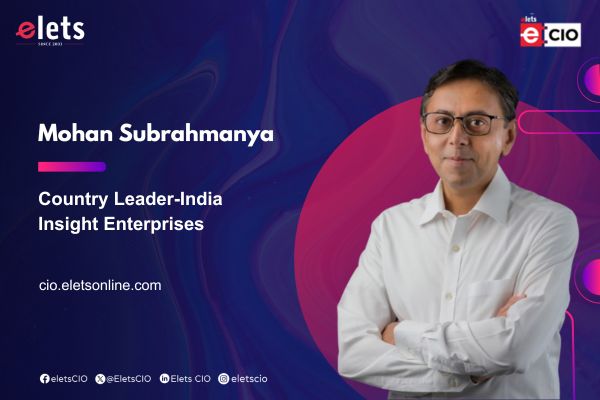
Enterprises must start by building a trusted, AI-ready foundation data that is accurate, timely, secure and discoverable. In India, four in 10 enterprises already prioritize data quality to prepare for generative AI and retrieval-augmented generation (RAG) shared Maurizio Garavello, SVP, Asia Pacific & Japan (APJ), Qlik in an exclusive interaction with Kaanchi Chawla of Elets News Network (ENN). Edited excerpts:
Many organizations are investing heavily in AI, yet often struggle to see meaningful ROI. In your view, how do legacy data architectures contribute to this disconnect?

Legacy data architectures prevent AI from delivering value. They fragment and isolate information, blocking models from accessing the accurate, timely data they need. As a result, more than 80% of AI projects never reach production, and only a quarter of organisations report measurable returns. In India, over half of enterprises still cannot make their data AI-ready, and one in three leaders cite poor data quality as their top barrier.

Modernising the data foundation reverses this. By integrating, governing and enriching data in real time, enterprises eliminate silos, cut infrastructure costs and establish secure, discoverable flows across the business. With this unified approach, AI models train effectively, scale faster and generate outcomes that justify investment.

Data lakehouses are increasingly being positioned as the future of enterprise data architecture. How do they address the limitations of traditional data warehouses and data lakes, especially in the context of powering AI initiatives?
Data lakehouses combine the strengths of data warehouses and data lakes, enabling enterprises to store, analyze and use massive data sets with more speed and efficiency. Traditional systems often create fragmented environments and escalating infrastructure costs that slow down AI adoption.
Lakehouses resolve this. By using open standards such as Apache Iceberg, lakehouses manage data with both precision and scale. They deliver fast, secure analysis of structured and unstructured data alike; capabilities that are essential for powering generative and multimodal AI.
For AI initiatives, lakehouses decouple storage from compute, giving enterprises the freedom to run multiple analytics and machine-learning engines without vendor lock-in. For instance, Qlik’s Open Lakehouse expands on this by optimizing ingestion and queries, driving up to five times faster performance and significant cost savings, all within a governed environment built for AI at scale.
What are some common misconceptions enterprise leaders have about AI readiness, and how can a modern data fabric built on openness and interoperability help correct these assumptions?
Many leaders assume their data is AI-ready. Research by Bain & Company shows otherwise: 32% of enterprise data isn’t fit for AI, and 30% of executives cite poor data quality as their biggest obstacle. Another misconception is that only large proprietary models matter. In reality, analysts predict most enterprise use cases will rely on smaller, more efficient models by 2026. Leaders also underestimate governance and skills; only one in four companies has a formal AI strategy, and nearly half face major talent gaps.
A modern data fabric built on openness and interoperability corrects these gaps. By unifying metadata, enabling real-time integration and adopting open table formats such as Apache Iceberg, enterprises create a trusted foundation that is accurate, secure and discoverable. This architecture enforces governance, reduces risk and gives organizations the confidence to scale AI responsibly.
Also Read: Powering India’s AI Growth with Sustainable Data Centers
From your perspective, what role does real-time data integration and active metadata play in enabling more trustworthy and explainable AI?
Real-time data integration ensures AI models use the most current and relevant information. By enabling high-throughput, low-latency ingestion from diverse sources, platforms built on open lakehouse principles keep AI models continuously updated. This immediacy is vital in scenarios such as fraud detection or supply-chain optimization, where stale inputs can compromise outcomes.
Active metadata makes AI explainable. It captures lineage, schema changes and quality metrics, creating a full audit trail of data transformations. With this visibility, enterprises can comply with emerging regulations like the EU AI Act and detect bias more effectively. Together, real-time integration and active metadata provide the auditable foundation enterprises need to build ethical and accountable AI.
As AI and analytics become embedded in day-to-day decision-making, what are some best practices enterprises should adopt to future-proof their data architecture?
Enterprises must start by building a trusted, AI-ready foundation data that is accurate, timely, secure and discoverable. In India, four in 10 enterprises already prioritize data quality to prepare for generative AI and retrieval-augmented generation (RAG).
They must also modernize architecture. Scalable and open environments such as data lakehouses, built on standards like Apache Iceberg, decouple storage from compute, eliminating lock-in and improving flexibility. In markets such as India and Australia, most organizations now view cloud migration as critical for real-time pipelines and modernization.
Governance must follow. A majority of enterprises plan to formalize AI risk policies in the next two years. Finally, even as AI adoption accelerates, leaders must preserve human oversight. By investing in continuous learning and upskilling, enterprises ensure responsible AI adoption and empower people to remain central to decision-making.
Be a part of Elets Collaborative Initiatives. Join Us for Upcoming Events and explore business opportunities. Like us on Facebook , connect with us on LinkedIn and follow us on Twitter.
"Exciting news! Elets technomedia is now on WhatsApp Channels Subscribe today by clicking the link and stay updated with the latest insights!" Click here!












